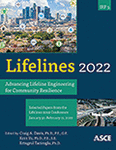Economic Consequences of the HayWired Earthquake Scenario
Publication: Lifelines 2022
ABSTRACT
This study evaluates the economic impacts of a Mw7.0 Hayward fault scenario earthquake on the greater San Francisco Bay Region’s economy and the California economy as a whole using a detailed multiregional, static computable general equilibrium model. Economic impacts in terms of Gross Regional Product (GRP) losses caused by both capital stock (building and content) damages and water and electricity utilities, and telecommunications-service disruptions are estimated. The results indicate that the total losses are primarily caused by capital stock damages. In the 6 months following the earthquake, total GRP losses are estimated to be $44.2 billion (4.2 percent of California’s projected baseline GRP over the period), but this result could be reduced by about 43 percent to $25.3 billion after factoring in microeconomic resilience tactics. The GRP losses associated with lifeline service disruptions are estimated to be $1.4 billion, which can be reduced by over 85 percent when resilience tactics are implemented. The most effective tactics are the ability to make up lost production by people working overtime or extra shifts (production recapture), making greater use of processes that do not need disrupted goods or services (production isolation), and substituting for disrupted supplies and services (input substitution), though their impact varies across the various causal factors influencing GRP losses.
Get full access to this article
View all available purchase options and get full access to this chapter.
REFERENCES
Cutter, S. (2016). “The landscape of disaster resilience indicators in the USA.” Natural Hazards, v. 80, p. 741–758.
FEMA. (2012). Hazus multi-hazard loss estimation methodology, earthquake model, Hazus®-MH 2.1 technical manual:. Federal Emergency Management Agency, Mitigation Division, 718 p., accessed June 20, 2019, at https://www.fema.gov/media-library-data/20130726-1820-25045-6286/hzmh2_1_eq_tm.pdf.
Holling, C. (1973). “Resilience and stability of ecological systems.” Annual Review of Ecology and Systematics, v. 4, p. 1–23.
IMPLAN. (2014). Impact Analysis for Planning (IMPLAN) System. Huntersville, NC.
Johnson, L. A., Jones, J. L., Wein, A. M., and Peters, J. A. (2020). “Analysis of communities at risk in the HayWired scenario.” chap. U in The HayWired earthquake scenario—Societal consequences, Detweiler, S.T., and Wein, A.M., eds. U.S. Geological Survey Scientific Investigations Report 2017–5013–R–W, 139 p., https://doi.org/10.3133/sir20175013v3.
Jones, J., Wein, A., Schweikert, A., and Ballanti, L. (2020). “Lifeline Infrastructure and Collocation Exposure to the HayWired Earthquake Scenario—A Summary of Hazards and Potential Service Disruptions,” Chapter T in The HayWired earthquake scenario—Societal consequences, Detweiler, S.T., and Wein, A.M., eds. U.S. Geological Survey Scientific Investigations Report 2017–5013–R–W.
Kroll, C., Lu, S., Wein, A., and Olsen, A. (2020). “The economic effects of the HayWired Scenario using the Association of Bay Area Governments regional growth forecast,” Chapter V3 in The HayWired earthquake scenario—Societal consequences, Detweiler, S.T., and Wein, A.M., eds. U.S. Geological Survey Scientific Investigations Report 2017–5013–R–W.
Kroll, C., Jaramillo, J., Lu, S., Olsen, A., Bello, O., Tan, A., Yin, W., Germeraad, M., and Jacoby, R. (2017). San Francisco Bay area comprehensive economic development strategy. San Francisco, Calif., Association of Bay Area Governments, 57 p., accessed October13, 2020, at https://abag.ca.gov/sites/default/files/complete_ceds_with_all_appendices.pdf.
Pimm, S. L. (1984). “The complexity and stability of ecosystems.” Nature, v. 307, p. 321–326.
Porter, K. A. (2018). “A new model of water-network resilience, with application to the HayWired scenario.” chap. N in The HayWired earthquake scenario—Engineering implications, Detweiler, S.T., and Wein, A.M., eds. U.S. Geological Survey Scientific Investigations Report 2017–5013–I–Q, 429 p., https://doi.org/10.3133/sir20175013v2.
Rose, A. (2007). Economic resilience to disasters: Multidisciplinary origins and contextual dimensions, Environmental Hazards: Human and Social Dimensions, v. 7, no.4, 383–398.
Rose, A. (2009). Economic resilience to disasters, Oak Ridge, Tenn., Oak Ridge National Laboratory, Community and Regional Resilience Institute, 58 p.
Rose, A. (2017). “Benefit-Cost Analysis of Economic Resilience.” in Oxford research encyclopedia of natural hazard science, Cutter, S., ed. New York, Oxford University Press.
Scawthorn, C. (2018). “Fire following the HayWired scenario mainshock.” chap. P in The HayWired earthquake scenario—Engineering implications, Detweiler, S.T., and Wein, A.M., eds. U.S. Geological Survey Scientific Investigations Report 2017–5013–I–Q, 429 p., https://doi.org/10.3133/sir20175013v2.
Seligson, H. A., Wein, A. M., and Jones, J. L. (2018). “HayWired scenario—Hazus analyses of the mainshock and aftershocks.” chap. J in The HayWired earthquake scenario—Engineering implications, Detweiler, S.T., and Wein, A.M., eds. U.S. Geological Survey Scientific Investigations Report 2017–5013–I– Q, 429 p., https://doi.org/10.3133/sir20175013v2.
Sue Wing, I. (2009). “Computable general equilibrium models for the analysis of energy and climate policies.” in International handbook on the economics of energy, Evans J. and Hunt, L.C., eds. Cheltenham, U.K., Edward Elgar Publishing, p. 332–366.
Sue Wing, I., and Balistreri, E. J. (2018). “Computable general equilibrium models for economic policy evaluation and economic consequence analysis” in The Oxford Handbook of Computational Economics and Finance, Chen, S.-H., Kaboudan, M., and Du, Y.-R., eds. Oxford Handbooks: New York, N.Y., Oxford University Press, p. 139–203.
Sue Wing, I., Wei, D., Rose, A., and Wein, A. (2020). “Economic consequences of the HayWired scenario: Digital and utility network linkages and resilience,” Chapter V2 in The HayWired earthquake scenario—Societal consequences, Detweiler, S. T., and Wein, A.M., eds. U.S. Geological Survey Scientific Investigations Report 2017–5013–R–W.
Wei, D., Chen, Z., and Rose, A. (2020). “Evaluating the role of resilience in recovering from major port disruptions: A multi-regional analysis.” Papers in Regional Science, vol. 99, no. 6, p. 1691–1722.
Wein, A., and Rose, A. (2011). “Economic resilience lessons from the ShakeOut earthquake scenario.” Earthquake Spectra, v. 27, no. 2, p. 559–573.
Wein, A. M., Witkowski, D. T., Jones, J. L., Porter, K. A., Ballanti, L. R., and McBride, S. K. (2021). “The HayWired Scenario—Telecommunications and information communication technology.” chap. S in The HayWired earthquake scenario—Societal consequences, Detweiler, S.T., and Wein, A.M., eds. U.S. Geological Survey Scientific Investigations Report 2017–5013–R–W, https://doi.org/10.3133/sir20175013v3.
Information & Authors
Information
Published In
History
Published online: Nov 16, 2022
Authors
Metrics & Citations
Metrics
Citations
Download citation
If you have the appropriate software installed, you can download article citation data to the citation manager of your choice. Simply select your manager software from the list below and click Download.
